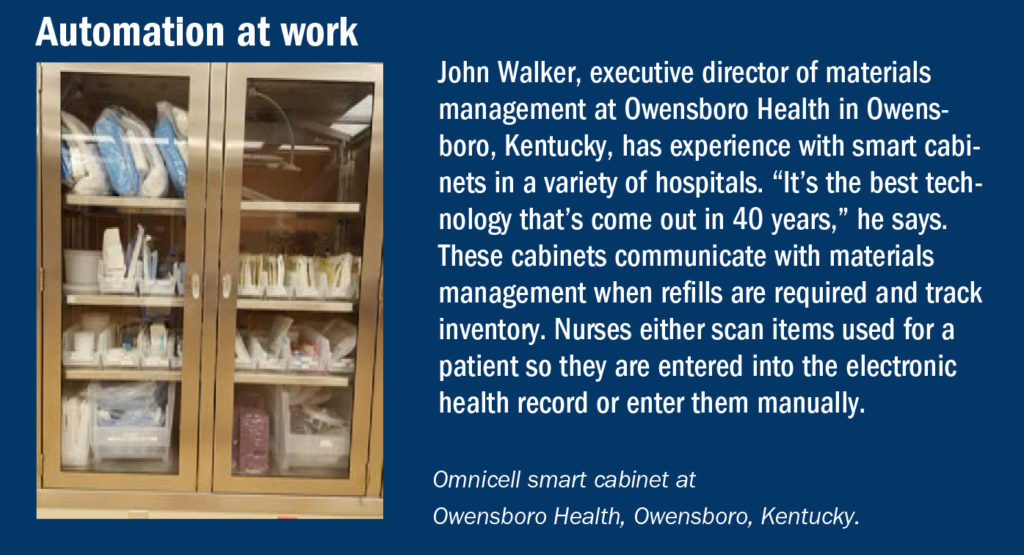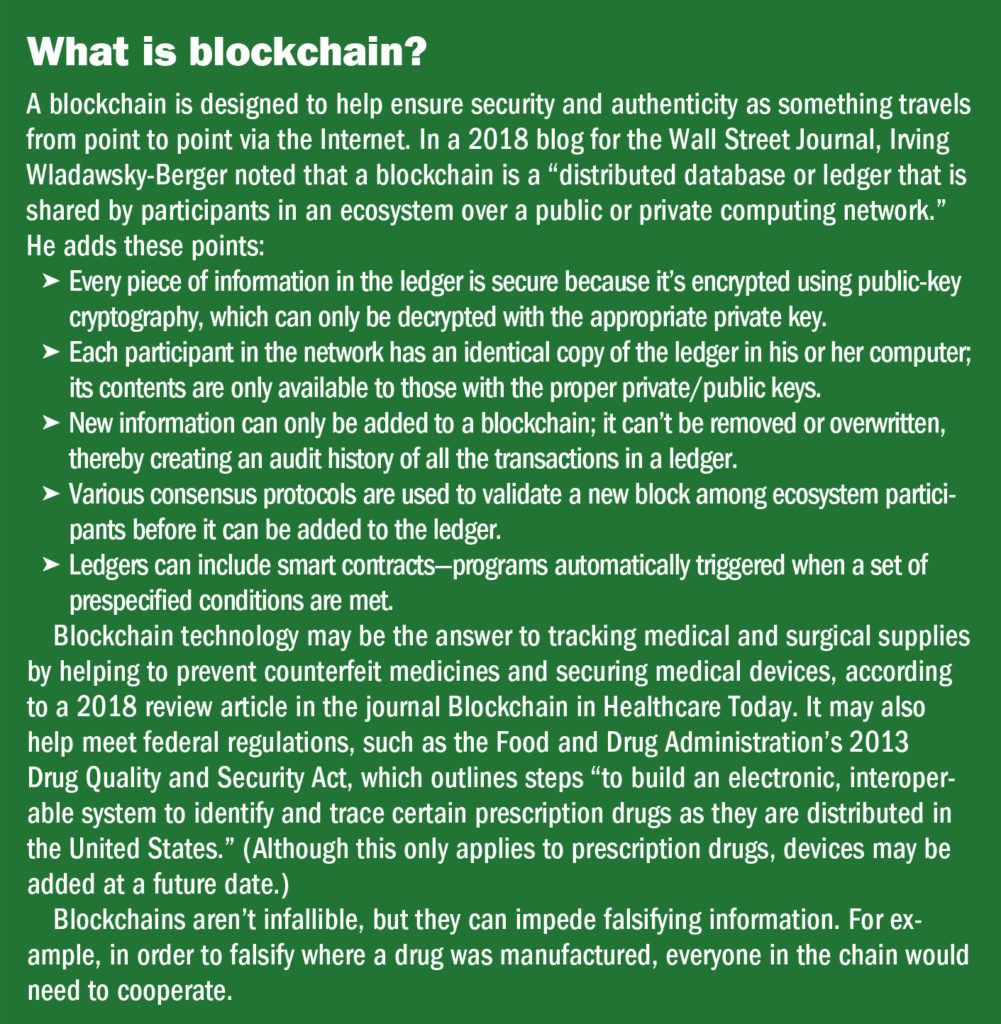Supply chain is ripe for innovation, as Amazon Business and technology manufacturers have discovered. In part 1 of this two-part series, we focused on the company's role in the supply chain (OR Manager, February 2019, 1, 9-12). In part 2, we look at technology-related trends and innovations that can improve the supply chain, including what some experts expect might happen in the future.
Automation through technology
One of the biggest trends in supply chain that will continue to grow in importance is automation achieved through technology. Automation reduces work of nursing and supply chain personnel and allows OR staff to get out of the counting, ordering, and "putting away" equation, according to Jamie Kowalski, MBA, FACHE. "Nurses have clearly stated they are more interested in taking care of patients than ordering supplies," says Kowalski, founder of Jamie C. Kowalski Consulting, LLC, a healthcare supply chain management company in Whitefish Bay, Wisconsin.
Tools such as bin systems, smart cabinets, and handheld radio-frequency identification (RFID) devices, many of which use barcode technology, are making inventory management easier.
An example of a bin system is the two-bin Kanban system from Tecsys (Montreal, Canada). Items are divided into primary and secondary bins. When the primary bin is empty, staff start using supplies from the secondary bin.
They also place the bin tag, which contains an RFID transponder, on a board near the storage unit, and information is transmitted to the hospital's materials management information system, which generates a pick list for stock items or a requisition for items that need to be purchased. When materials management staff deliver the new items, they transfer remaining supplies to the primary bin and put the new supplies in the secondary bin.
 Omnicell smart cabinets at Owensboro Health in Owensboro, Kentucky, are another example of technology improving automation, says John Walker, executive director of materials management. Walker used a similar product by PIXIS in a previous role, and finds both to be valuable tools (sidebar right). "On a given day we have some 20,000 items that have to be where they are needed. Automation makes [fulfilling] our mission faster and safer," he says.
Omnicell smart cabinets at Owensboro Health in Owensboro, Kentucky, are another example of technology improving automation, says John Walker, executive director of materials management. Walker used a similar product by PIXIS in a previous role, and finds both to be valuable tools (sidebar right). "On a given day we have some 20,000 items that have to be where they are needed. Automation makes [fulfilling] our mission faster and safer," he says.
Handheld RFID devices are helping to ensure optimal periodic automatic replenishment (PAR) levels at Inova Fairfax Medical Campus in Falls Church, Virginia, according to Kevin Youmans, MHA, vice president of surgical services. The devices were part of an overall plan to standardize ordering that included meeting with service line leaders to determine appropriate PAR levels. The devices improve accuracy by detecting exactly how many items are in a bin and linking the information to utilization. Before these devices were available, staff had to estimate the number of products.
"Once we aligned PAR and increased the use of handheld devices, we were able to reduce inventory by $900,000," Youmans says. Adding nurse auditors to check every patient bill to ensure that they contain the correct charges and that all implants used in the case are documented in the medical record increased charge capture by more than $2.3 million.
Inova also implemented a standard process for "stat" orders, which reduced the number of these orders from as many as 2,016 in one month to between 140 and 150.
In July 2019, Inova plans to start using handheld devices to track case cart items. "Items on the cart will be scanned when they are picked for the surgery," Youmans says. That means anything on the cart used for the patient doesn't have to be scanned to the patient's chart.
"It's assumed that what's on the cart was used for the patient," he says. The supply chain team will scan items left on the cart and return them to inventory.
Inova also plans to implement a preference card software module that provides data on what the surgeon does and does not use in each case, so that preference cards can be adjusted regularly based on data.
Technology doesn't only play a role in automation. "IT [information technology] has become the crux of the healthcare system," says Mary Lou Jones, BSN, CSSM, business manager at Maricopa Integrated Health System in Phoenix. At Maricopa, ordering and billing are done electronically via an interface with the medical record.
"[The technology] decreases the amount of time and resources needed to manage supply chain, and any vendor price increase can be easily entered into the item master so you are collecting what you are entitled to," Jones says.
Contracts can also be loaded onto a third-party platform that flags anything not on contract. "It provides real-time invoicing and inventory check," Jones says. One example is eCommerce Exchange (Vizient, Inc, Irving, Texas), a web-based portal that connects hospitals to suppliers.
Jones cautions that the increased use of technology requires ensuring cybersecurity. In addition, Kowalski notes, technology costs money. Each additional investment in technology must be analyzed to make sure the investment provides a return or pays for itself.
Data management and technology integration
Technology and the focus on outcomes have resulted in an almost never-ending supply of data, but managing that data and integrating the technologies that provide it remains difficult. When GHX, a healthcare business and data automation company headquartered in Louisville, Colorado, asked supply chain leaders in a 2018 survey to identify supply chain priorities for 2018, 59% chose data and analytics for better decision making.
Ensuring data accuracy and then analyzing data takes time. "We spend a lot of time trying to get data normalized so that it's useful for our members," says Stephen Downey, group SVP for supply chain operations at Vizient. The Food and Drug Administration's requirement of unique device identifiers (UDIs) for medical devices has helped, but Downey notes that UDI for Class 1 items won't be required until late 2020, so the standard is still rolling out.
"The amount of data we now receive is incredible," says Walker, who turns to external resources for help with data management:
• GHX checks purchase order prices against contracts to identify whether a charge is correct.
• ECRI Institute (Plymouth Meeting, Pennsylvania) provides a monthly Excel report that benchmarks what Walker's organization has been paying against other hospitals. All capital purchases are checked for price and safety record.
"It's complicated because of the number of things we buy and the number of contracts that we have," Walker says.
Respondents to a 2018 survey of providers and suppliers by CAPS Research, a nonprofit research center in Tempe, Arizona, identified several issues related to integration that were important, including integrating supply chain data and clinical data (85% of respondents) and achieving IT integration (82%).
Although much technology exists in different areas, such as preference cards, payments, and inventory, the ability to tie technology together and to integrate data into the electronic health record is lacking, says Downey. He anticipates that will change in the future: "I think we'll see synergy in that, for example, the supplier and the scheduling system will be connected so you will know way ahead of time what inventory you will need," he says, adding that the information will also be tied into hospital formulary and preference cards. "Information flow is the key."
Looking ahead
 What else is on the horizon for supply chain? "Trying to manage the clinical/supply integration piece is important," Downey says. "How do you get the right alignment of clinicians with what products are in the market? I think we'll see a lot of technology support on that front." Other trends that Downey sees include:
What else is on the horizon for supply chain? "Trying to manage the clinical/supply integration piece is important," Downey says. "How do you get the right alignment of clinicians with what products are in the market? I think we'll see a lot of technology support on that front." Other trends that Downey sees include:
• Hospitals will continue to look for ways to automate ordering and distribution. Downey cites the example of a customer who placed cameras in the supply room so that supply chain personnel can watch for empty bins. When they see a product that needs to be reordered, a replenishment order is created and the distributor can have the product delivered the same day. "It's not new technology, but it's taking existing technology to streamline the process," Downey says.
• Technology will be used to manage possible and actual supply disruption caused by natural disasters (eg, a medical device recall or the IV shortages that occurred after the 2017 hurricane in Puerto Rico) or quality issues. "Other industries have approached supply chain continuity pretty robustly, and there are some incredible tools that will map your supply chain, from primary down to tertiary supply sources, and help address prior performance management and how that factors into risk," Downey says. This allows organizations to better understand risks, monitor those risks, and be proactive. For instance, if a company sees that a natural disaster is heading for a particular location, it can check its supply lines for any possible disruption.
• As procedures move into the ambulatory setting, organizations must consider whether the same solutions, technologies, and best practices are occurring as the continuum of care shifts. "Our members are thinking about it, but it's not an equation that's been broadly solved yet," Downey says. Organizations need to consider whether to have the same or different technologies and determine how to leverage best practices of both inpatient and outpatient settings across that continuum.
Another possible trend that others have identified is the use of blockchain technology (sidebar above).
Strengthening partnerships
The relationship between OR and supply chain staff is more important than ever, given the current environment of disruption. Walker suggests OR leaders invite purchasing staff into the OR so they can see what is being used.
"I feel comfortable going up to the OR to talk about the equipment, and everyone in materials management should feel the same way," he says. Walker, whose department is charged for all supplies charged to a patient, tells the OR staff and manager about specific cost concerns so they can work through possible solutions. "The surgery staff is always eager to help," he says.
At Inova Fairfax, Youmans says, "we work very closely with supply chain from a value analysis perspective. We collect the data and new technology requests and work with them on streamlining the process." OR and supply chain leaders meet monthly about new technology and processes.
The bottom line is that OR and supply chain leaders will need to collaborate closely to meet both clinical and financial goals. ✥
Cynthia Saver, MS, RN, is president of CLS Development, Inc, Columbia, Maryland, which provides editorial services to healthcare publications.
References
Clauson K A, Breeden E A, Davidson C, et al. Leveraging blockchain technology to enhance supply chain management in healthcare. Blockchain in Healthcare Today. 2018. https://blockchainhealthcaretoday.com/index.php/journal/article/view/20/.
Cogmedix. Class I and class II medical devices. https://www.coghlincompanies.com/cogmedix-class-i-class-ii/.
Schneller E. 2018 healthcare supply chain trends/issues. Healthcare Purchasing News. 2018. https://www.hpnonline.com/2018-healthcare-supply-chain-trends-issues/.
Wladawsky-Berger I. Blockchain beyond the hype. Wall Street Journal. 2018. https://blogs.wsj.com/cio/2018/12/19/blockchain-beyond-the-hype/.



